Updated in June 2023 to give a 1 year performance update mention the new Cobalt Q-4 Slope.
There have been so many new rangefinders coming out these days, it’s hard to keep up with them all.
And with Bushnell being a little bit slow to come out with any new devices, much of the hype has come from some of the eager upstarts in the budget to mid-tier price range like Precision Pro and Blue Tees.
But there are a handful of companies on the higher end of the market that have been making rangefinders for years, that you probably aren’t hearing as much about in your Instagram feed.
Cobalt Golf is a great example of this.
They’ve been making rangefinders for 25 years, and considering they’re at a higher price point, with a lower marketing budget, you just don’t hear about them as much.
But recently, I got my hands on the Cobalt Q6 Slope rangefinder and put it through its paces.
And you know what? I came impressed.
Very, very impressed.
What makes it so good? Let’s take a look and find out.
First Impressions of the Cobalt Q6 Slope
One of the hallmarks of my golf rangefinder reviews lately has been to talk about presentation and packaging – because I really do think it can make a difference in the experience and perception of a product.
Some of the newer brands have really upped their presentation game for devices costing well under $300.
Well the Cobalt Q6 Slope plays in a different market with a price of $450.
So I was bit surprised when I opened up the shipping box to find packaging that was pretty unimpressive compared to many of the competitors in the market.
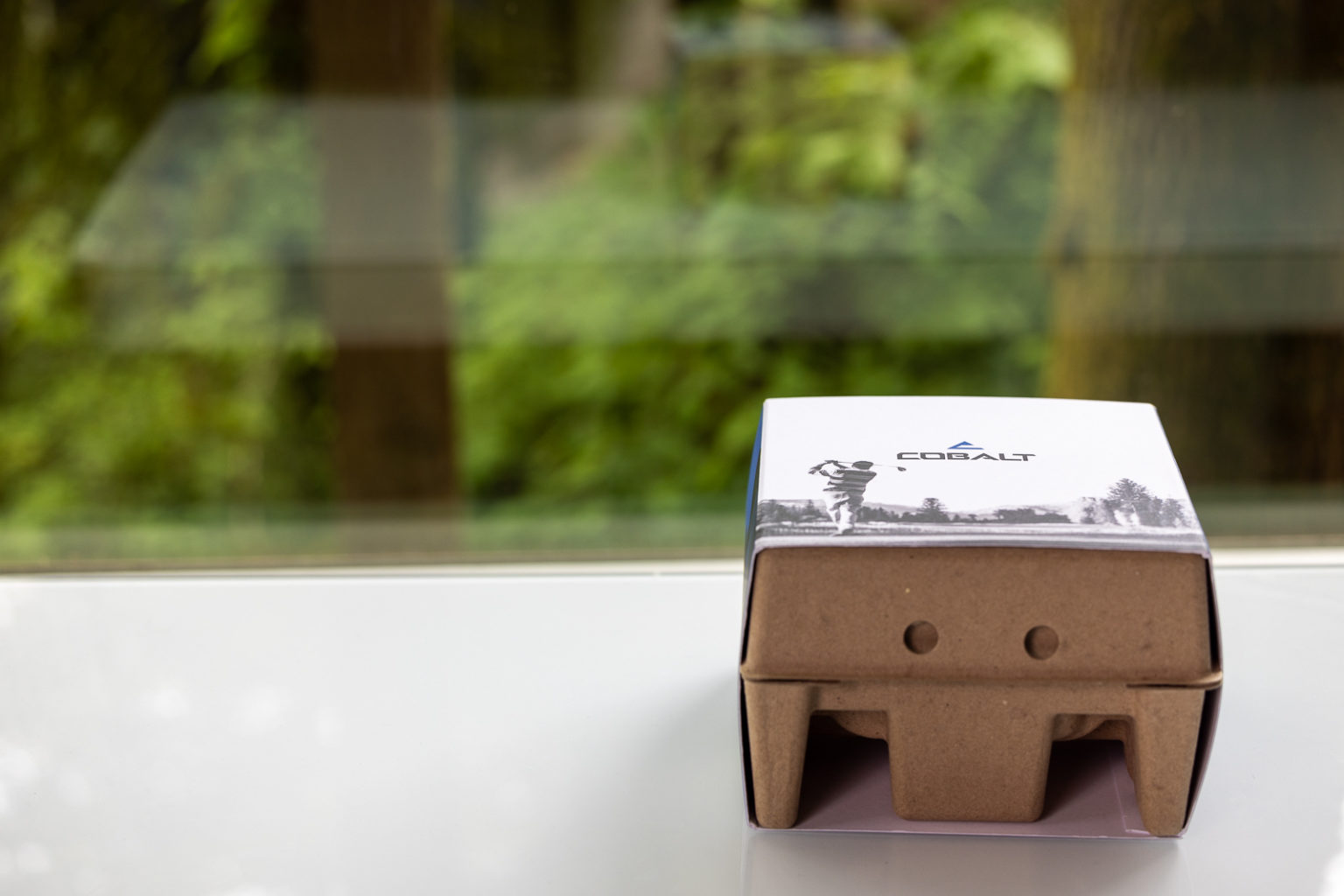
A basic sleeve slipped over some cardboard packaging, that doesn’t necessarily scream high-end product.
Inside is the Q6 device, a case, some instructions, and a microfiber towel.
Nothing out of the ordinary, and while the case is well done and a nice upgrade from a standard rangefinder case – you won’t be overly wowed by the presentation of it all.
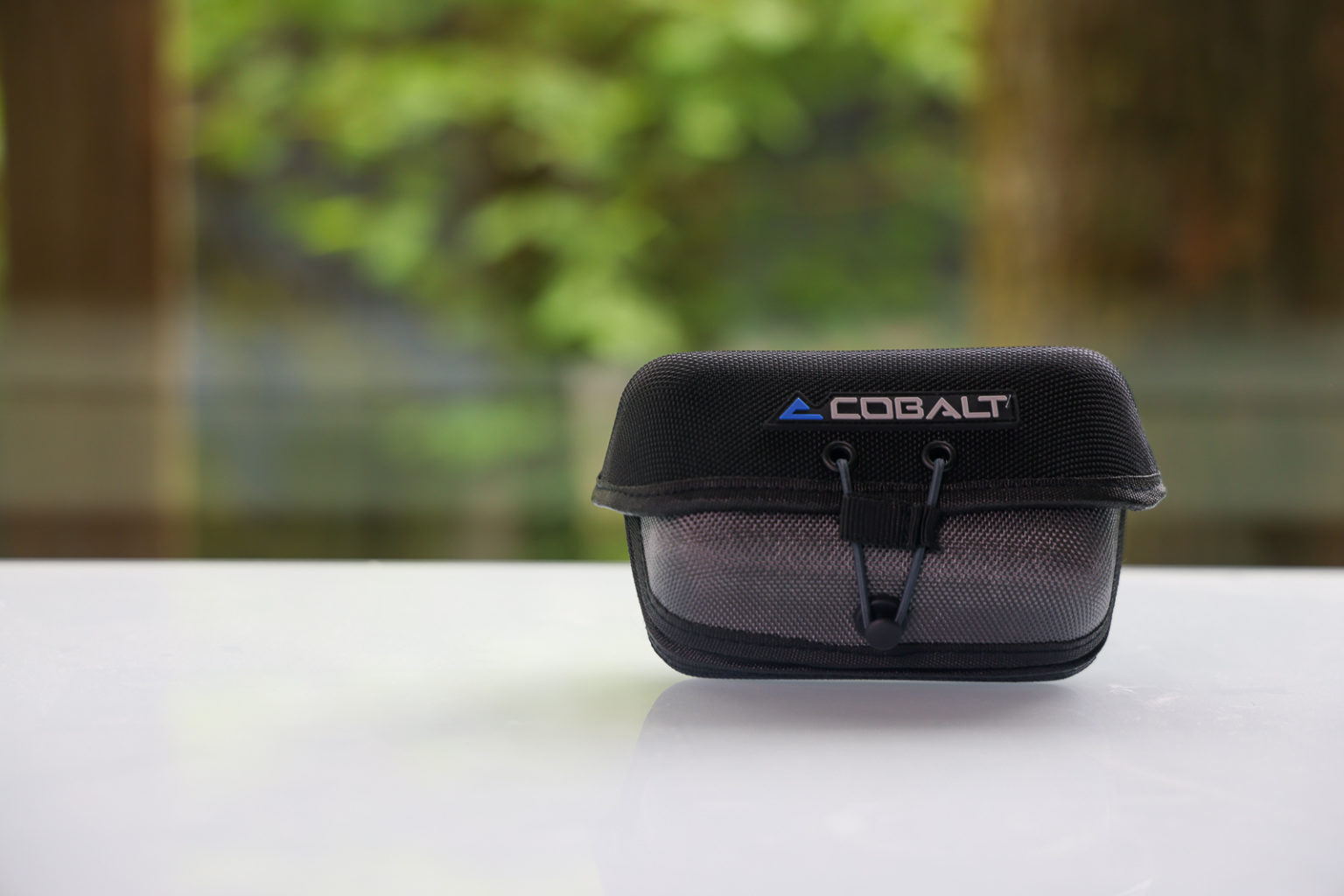
But you know what is special?
The device itself.
From the second you pick it up, you can tell this thing is a step up from most rangefinders on the market.
The Cobalt Q6 feels like a high-end product. I recently said that the Precision Pro NX10 was one of the first sub-$300 rangefinders to feel like more expensive devices – and that’s true.
But after holding the Cobalt Q6, it’s clear this is on another level. The magnesium body means there’s a nice weight to it, and this thing just feels expensive.
It’s rated at IPX7, so it’s completely waterproof, and the metal touches throughout its design add to the sturdy feel of the device.
I personally love the black and blue motif the device has, and I think it makes the Q6 one of the best-looking rangefinders on the market.
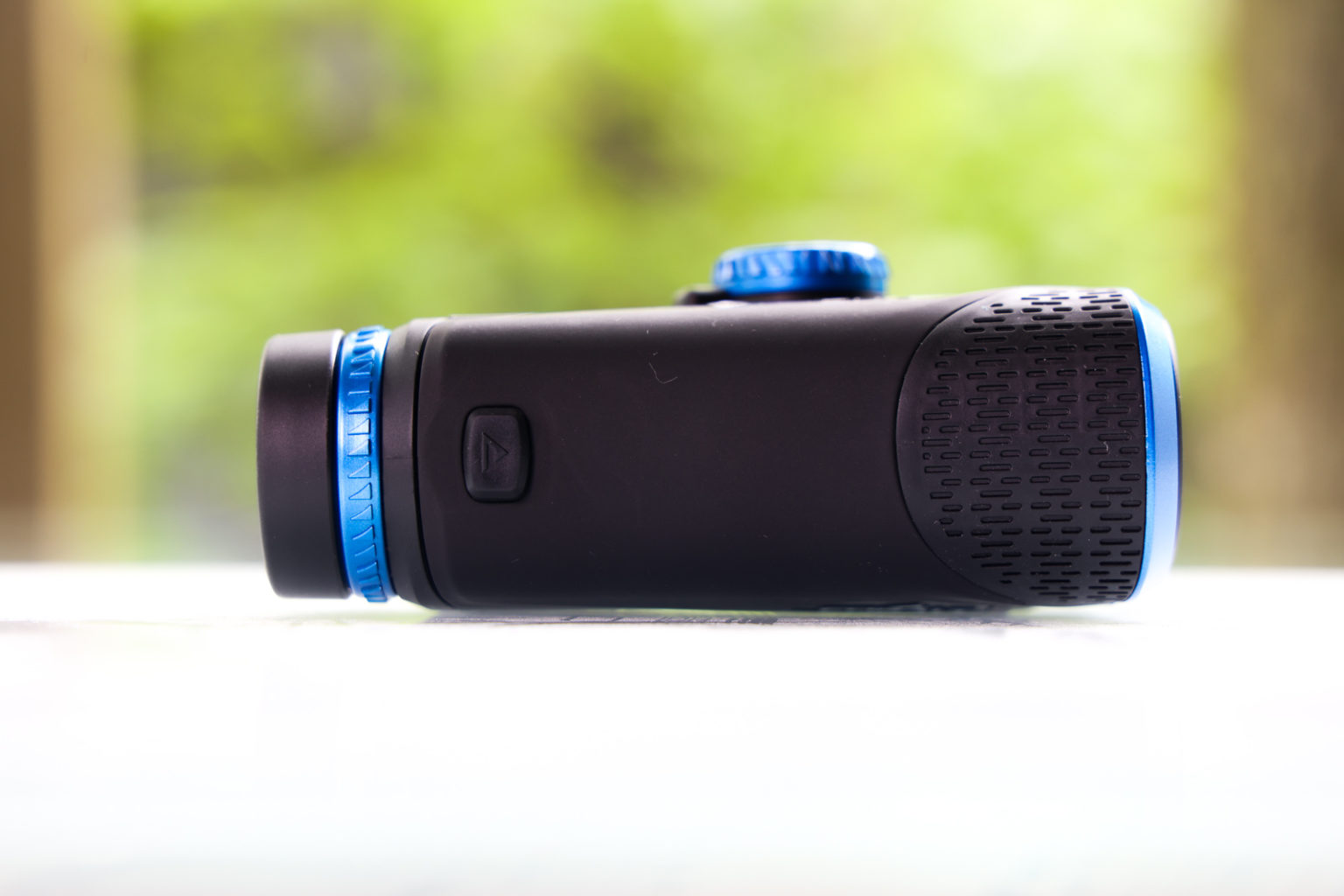
When first looking at it, there’s also one other prominent feature that’s impossible to ignore: the dial on the side of the device.
Cobalt calls this the “SmartSwitch” and it’s used to change the illumination in the display and to turn slope mode on and off.
This begs the question, does the switch actually work well? Or is it another gimmick meant to separate itself from the increasingly strong rangefinder competition? We’ll get to that in a second.
Take our 30 second quiz and I'll recommend the perfect golf rangefinder based on your budget, goals, and preferences.
Cobalt Q6 Slope Features
The Cobalt Q6 is a pretty feature-heavy rangefinder, which you’d expect from a device costing $450.
Cobalt Q6 Build Quality and Waterproof Rating
As I mentioned above it has a waterproof rating of IPX7, which means it can withstand water immersion of up to 3 feet for 30 minutes.
This is the highest rating I’ve ever seen on a rangefinder before. I don’t usually put too much stock in this, because how often are you immersing your rangefinder in water?
But what it does do is give you some insight into just how well built this thing is.
In fact, I might even go as far to say as it’s the most well-built device I’ve used to date.
It’s certainly on par with the Bushnell
Cobalt Q6 Optics and Display
One look in the Cobalt Q6 viewfinder, and it’s hard not to be impressed.
The 7x magnification is big and beautiful, and among the finest displays, I’ve seen.
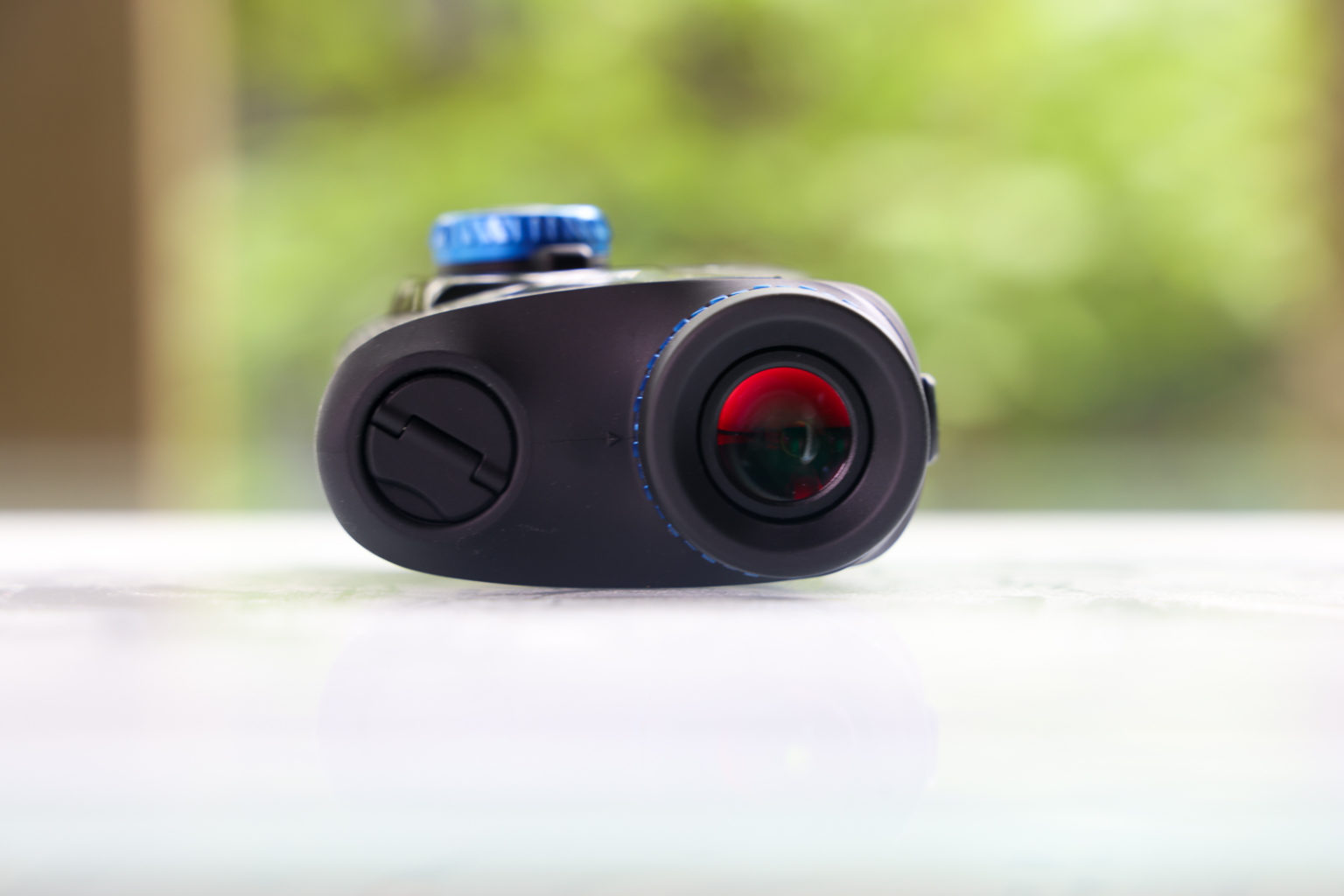
It’s right up there with the gold standard Nikon Pro II Stabilized, which has been my primary reference device for display and optics.
The Q6 has a full-time illuminated display, which is excellent.
I’ve commented in the past about how less expensive devices that include an ambient display often sacrifice quality in order to add to the bullet point list of features.
Unfortunately with these, the outside edge of the viewfinder can often get distorted or blurry when using the red display.
Not in the Cobalt Q6.
The clear red numbers are extremely crisp, sharp, and don’t degrade the optical image at all.
Remember the “SmartSwitch” we mentioned before? Well, this controls how bright your display is in the viewfinder, and it works beautifully.
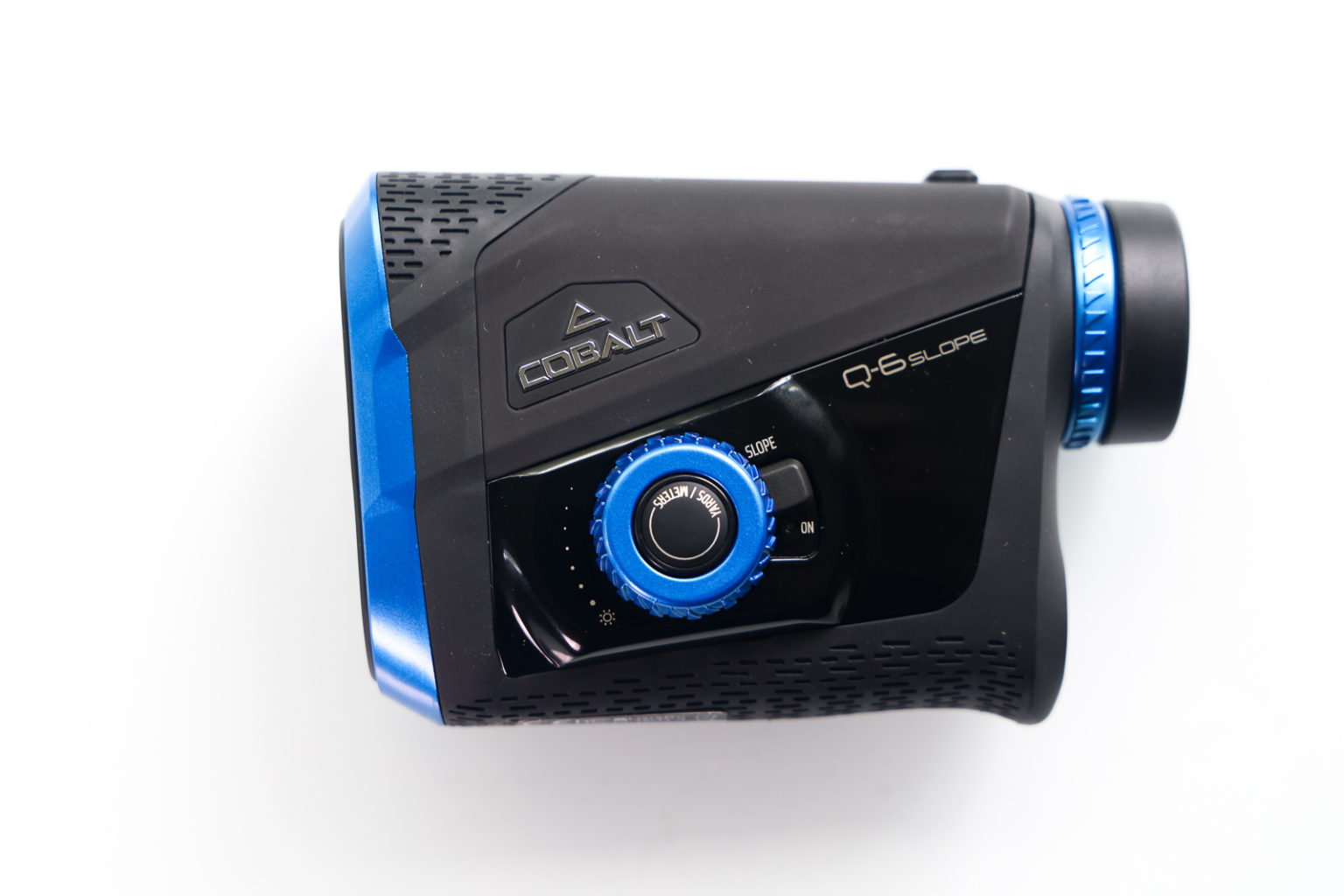
A turn of the dial can turn up or down the brightness immediately, and I actually found it to be more useful than I expected. When there was cloud cover or a darker situation you could easily ratchet up the brightness a little bit, or go the opposite direction when needed as well.
Ultimately, I found this to be a personal preference situation, but one that I have adjusted multiple times throughout my rounds to help my readings perfectly fit the surrounding environment.
The switch is definitely the most differentiating design element from its competitors, and I honestly have found myself really enjoying it.
Slope Functions on the Cobalt Q6 Slope
Integrated in to the SmartSwitch of the Cobalt Q6 Slope is a simple on/off switch for turning slope mode on and off.
One cool feature is when it’s on, there is a little light that is revealed beneath the switch that illuminates to let you (or any of your tournament playing partners) know that it’s in slope mode.
Slope on/off is one of those things different manufacturers have implemented in different ways, and this little light is one more way of doing something unique from their competition.
When looking through the viewfinder, the display is very minimal which I love.
I talked about this at length in my NX10 review, and I was pleased to see Cobalt follow a similar suit with the Q6.
You’ve got a box for ranging the flag, and then the yardage down to 1/10th of a yard.
That’s it. And that’s all I need or want.
In slope mode, they also did something I hadn’t seen before, which is only show the slope number.
When slope mode is on, it shows you the slope-adjusted distance in the same spot where it previously gave you the actual yardage. Then right below it tells you what degree of adjustment was necessary.
Some people will love this, and some will hate it.
It can be useful to know both slope and non-slope distances, and to get that, you’ll have to flip slope mode on and off.
Fortunately, the design makes this very fast and easy, but it is an extra step.
I personally prefer it this way, once again because I really enjoy an uncluttered viewfinder.
But I could see some golfers being annoyed at first at having to switch.
Others only care about the slope-adjusted number, and will have zero issues with this.
But overall the display and optics are among the best of any rangefinder I’ve used.
This is one of the most well-built and most accurate rangefinders we've ever used. Yes, there's a premium price, but it comes along with premium performance.
Cobalt Q6 Accuracy and Performance
Ok, I’m gonna be real honest here. My gut reaction after my first two rounds with the Cobalt Q6 was to say it’s the most accurate rangefinder I’ve ever used.
That feels weird to say, since these days most of the rangefinders I review on this site are very accurate.
But something about the Cobalt Q6 inspired more confidence than anything I’ve used previously.
In looking back I think there are two reasons for this.
The first is the fact it provides a distance down to a 1/10th of a yard.
Does anybody need this? No, of course they don’t. If the flag is 100.4 or 100.8 yards away, this will have no bearing on your shot no matter how good you are.
But, it was the consistency of the laser distances that inspired so much confidence. I’d shoot the same thing multiple times, and I’d get the exact same yardage over and over.
Whereas many less expensive rangefinders, might bounce around a yard or two.
This was very consistent and very fast with its numbers.
The second reason is due to the “Surge” feature.
Surge, Jolt, vibration – it’s all the same, depending on the brand.
When a device locks onto the flag, it vibrates to let you know it has indeed targeted the flag, and not a tree or something else in the background.
The NX10 basically vibrates every single time you get a distance.
I’ve had a hard time getting the
The Cobalt “Surge” feature, is the best implementation of this vibration technology I’ve ever used.
Why?
Because it only did it when it truly knows I’m locked on to the flag.
Shooting it on my deck at trees out in my backyard? Never got a vibration.
But take it out on the course, and on the first hole I got the vibration as well as a visual signal that it had the flag.
It does it frequently, but not all the time. So when I get it? I know with 100% confidence the distance is correct.
You combine these two things with wonderful build quality, and a history of high-quality products?
And my gut is to say this is the most accurate rangefinder I’ve ever used.
Or if not the most accurate, we’ll at least say it’s among the most confidence-inspiring devices I’ve used.
Final Thoughts on the Cobalt Q-6 Slope
The Cobalt Q-6 Slope is a wonderful product in a difficult market.
Here’s what I mean by that.
Both Precision Pro and Blue Tees have very good products in the $200-$260 range.
They’re accurate, feature-heavy, and affordable.
Cobalt even has its own less expensive model in the Q-4 Slope – which is fantastic.
At the high end of the market is Bushnell – the market leader.
These days you can likely find a last-gen
98% of tour players use Bushnell. It has a built-in magnet which the Cobalt does not.
All things being equal, most people are going to choose the Bushnell if for no other reason than that’s the company they’re familiar with, and that’s the brand they’re constantly seeing ads for.
But try and look past all of that.
If you’re able to move beyond the very good budget products, and the also very good and more popular Bushnell products – you’ll find the Cobalt Q6 Slope to be one of the very best rangefinders on the market.
The more I’ve used the Cobalt the more I’ve enjoyed it. The superior optics and wonderful display make it a joy to use.
The build quality inspires confidence in the brand.
And the 1/10th calculations and incredible implementation of target lock vibration inspired a confidence in the device that is a step up from other devices I’ve used.
It will be a hard sell for many of you, but I truly think you should consider the Cobalt Q6 Slope. Throw in the fact they’re a small company dedicated to customer support with a lifetime warranty – and you’ve not only got a fantastic product, you’ve got peace of mind as well.
I didn’t expect to like the Cobalt Q6 as much as I did. I didn’t expect it to perform as well as it did. But it’s a product that lives up to its more premium price point, and I think it should be a strong contender for anyone looking for a top-of-the-line rangefinder this year.
This is one of the most well-built and most accurate rangefinders we've ever used. Yes, there's a premium price, but it comes along with premium performance.
UPDATE July 2023: Still as Good as Ever
It’s been a year since I initially published this review, and I figured I’d update it with a little check in.
Over the past year, this is the device I’ve used more than any other. It’s that good. I trust its accuracy, the optics are fantastic, and more than anything I’ve just found it really enjoyable to use.
The only real issues I have are the fact that you can’t see both actual and slope-adjusted distances simultaneously, and that there’s no magnet.
But for the way I personally like to use a rangefinder (while carrying my clubs, and without slope) it works wonderfully.
If $450 still feels like a lot to spend, consider the brand-new Cobalt Q-4 Slope. It’s just as accurate, build quality is just as good, but the optics are a bit reduced to bring it down to under $300. It’s my pick for the best rangefinder at that price point.
This page contains affiliate links. This means that if you click a link and buy one of the products on this page, I may receive a commission (at no extra cost to you!) This doesn’t affect our opinions or our reviews. Everything we do is to benefit you as the reader, so all of our reviews are as honest and unbiased as possible.
One of the best golf rangefinders at any price point
Over the last 2 years, I've used the Cobalt Q-6 more than any other rangefinder. That should be all you need to know considering I own 30+. It's fantastic across the board. The downsides? No built in magnet, and you can't get both slope and non-slope distances simultaneously. Outside of that? It's as good as it gets.
The Good
- Fantastic Build Quality
- Top of the class in terms of accuracy and pin seeking
- Smart dial suprisingly useful
The Bad
- No built in magnet
- Can't see slope and non-slope distances simultaneously
-
Presentation
-
Performance
-
Price
-
Personal Affinity

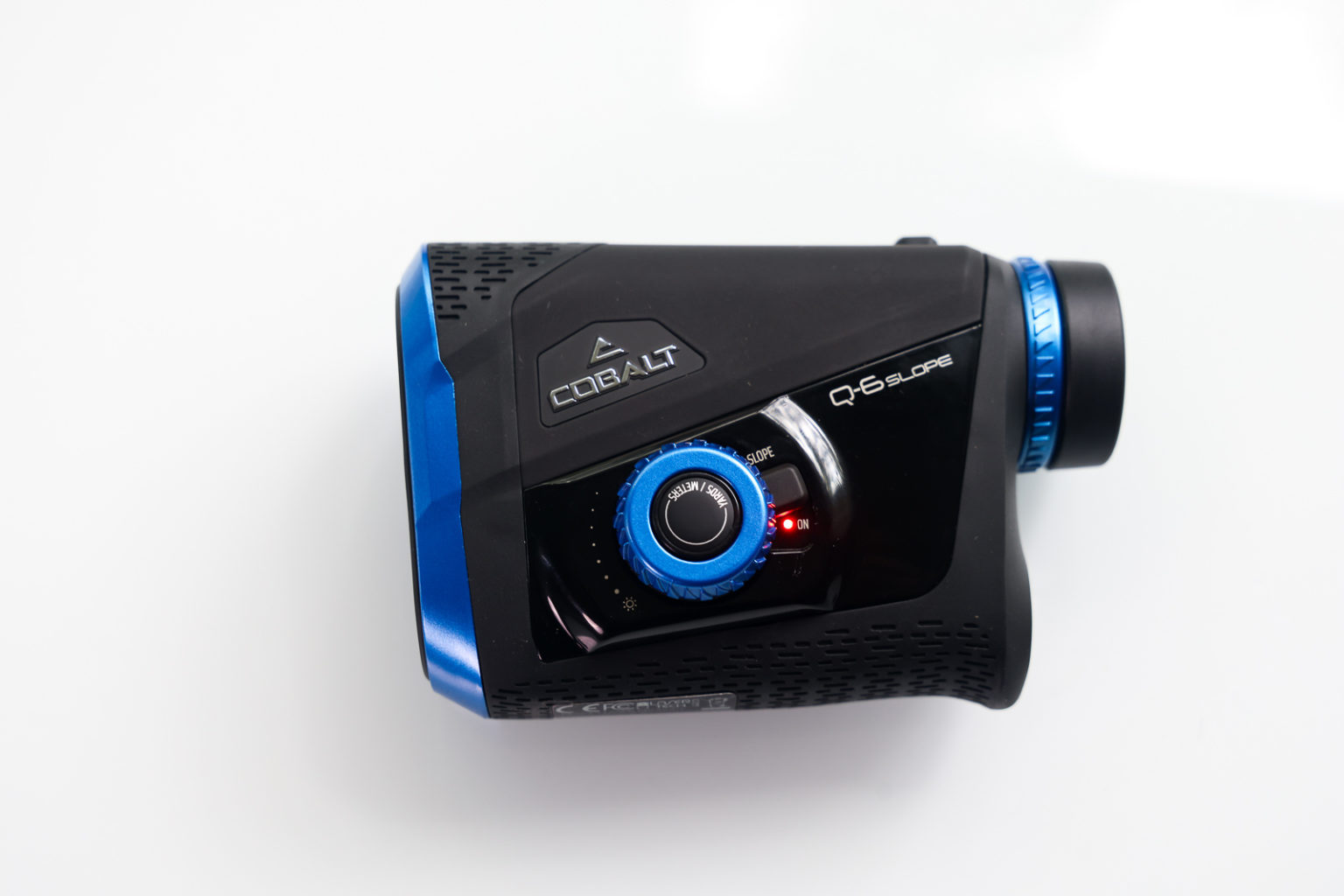
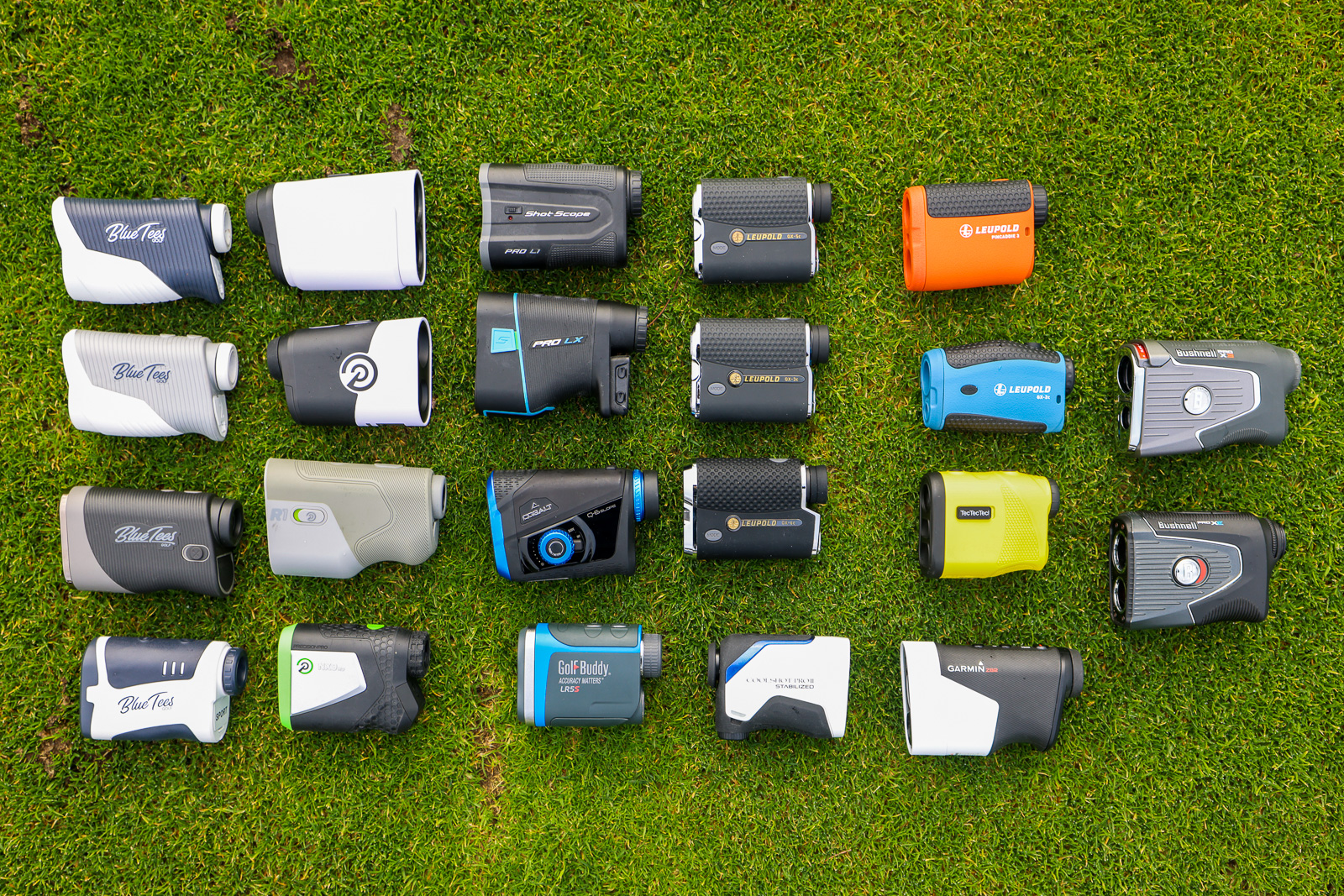
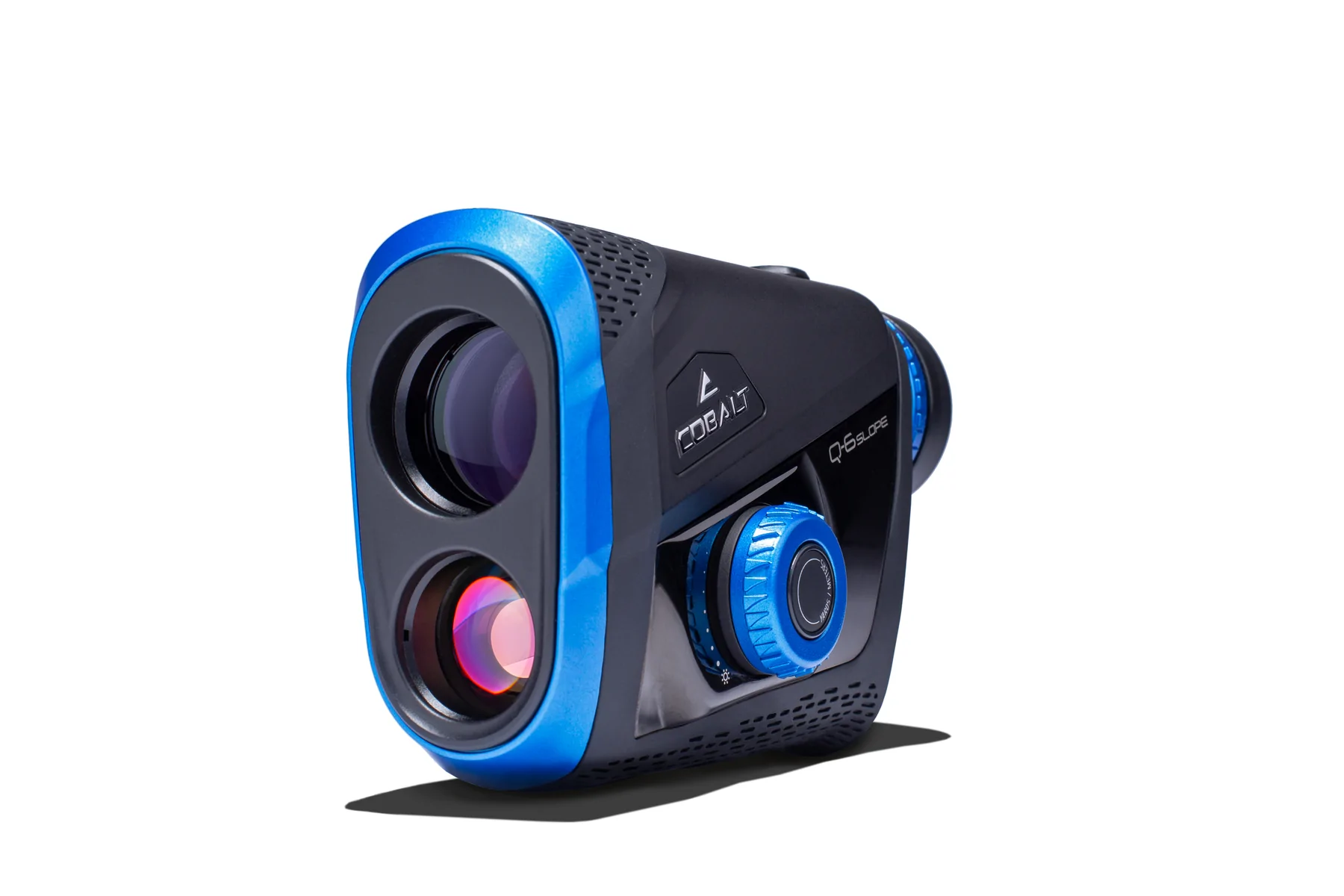
4 Comments
Do you have any coupon codes for the q6?
I don’t, but will see what I can do!
Sean,
Based on your review I took the plunge and bought a Cobalt. Previously I was a Nikon fan, having used 2 different models over the past 12 years.
I have to say I have been extremely pleased with the Cobalt. It was everything you said it was. The standouts for me are the quality, solid feel, brightness of the image, the ease of use. I do miss the Nikon stabilization feature but the the Cobalt more than makes up for it in its features. Excellent value for an outstanding product. Thanks again for such an excellent, well written review. Keep up the great work!
Great review! One comment on the packaging. They should be lauded because it is designed to be easily recyclable and to reduce the wasteful albeit luxurious looking and feeling packaging that has been used in the past but which cannot be easily recycled. So I am actually impressed with their basic looking packaging. It’s cheaper for them and better for the environment so a win-win.